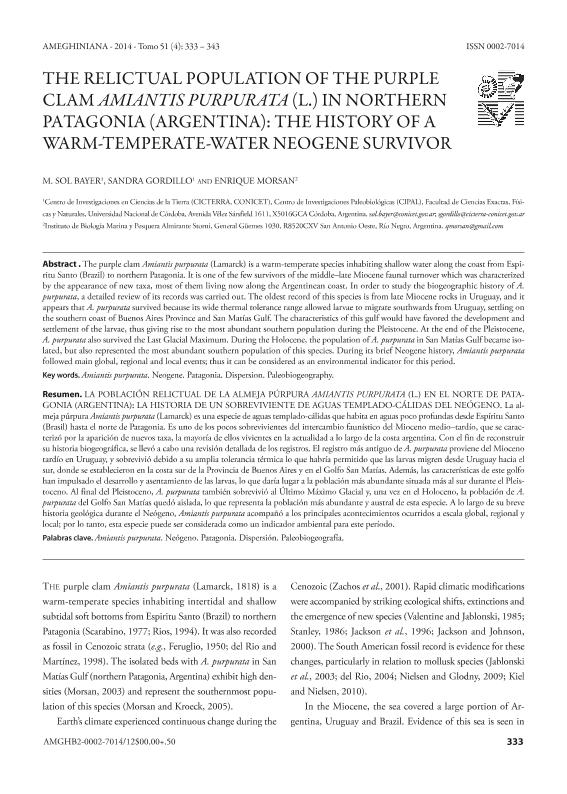Artículo
The purple clam Amiantis purpurata (Lamarck) is a warm-temperate species inhabiting shallow water along the coast from Espiritu Santo (Brazil) to northern Patagonia. It is one of the few survivors of the middle–late Miocene faunal turnover which was characterized by the appearance of new taxa, most of them living now along the Argentinean coast. In order to study the biogeographic history of A. purpurata, a detailed review of its records was carried out. The oldest record of this species is from late Miocene rocks in Uruguay, and it appears that A. purpurata survived because its wide thermal tolerance range allowed larvae to migrate southwards from Uruguay, settling on the southern coast of Buenos Aires Province and San Matías Gulf. The characteristics of this gulf would have favored the development and settlement of the larvae, thus giving rise to the most abundant southern population during the Pleistocene. At the end of the Pleistocene, A. purpurata also survived the Last Glacial Maximum. During the Holocene, the population of A. purpurata in San Matías Gulf became isolated, but also represented the most abundant southern population of this species. During its brief Neogene history, Amiantis purpurata followed main global, regional and local events; thus it can be considered as an environmental indicator for this period. La almeja púrpura Amiantis purpurata (Lamarck) es una especie de aguas templado-cálidas que habita en aguas poco profundas desde Espíritu Santo (Brasil) hasta el norte de Patagonia. Es uno de los pocos sobrevivientes del intercambio faunístico del Mioceno medio–tardío, que se caracterizó por la aparición de nuevos taxa, la mayoría de ellos vivientes en la actualidad a lo largo de la costa argentina. Con el fin de reconstruir su historia biogeográfica, se llevó a cabo una revisión detallada de los registros. El registro más antiguo de A. purpurata proviene del Mioceno tardío en Uruguay, y sobrevivió debido a su amplia tolerancia térmica lo que habría permitido que las larvas migren desde Uruguay hacia el sur, donde se establecieron en la costa sur de la Provincia de Buenos Aires y en el Golfo San Matías. Además, las características de este golfo han impulsado el desarrollo y asentamiento de las larvas, lo que daría lugar a la población más abundante situada más al sur durante el Pleistoceno. Al final del Pleistoceno, A. purpurata también sobrevivió al Último Máximo Glacial y, una vez en el Holoceno, la población de A. purpurata del Golfo San Matías quedó aislada, lo que representa la población más abundante y austral de esta especie. A lo largo de su breve historia geológica durante el Neógeno, Amiantis purpurata acompañó a los principales acontecimientos ocurridos a escala global, regional y local; por lo tanto, esta especie puede ser considerada como un indicador ambiental para este período.
The relictual population of the purple clam Amiantis Purpurata (l.) in northern Patagonia (Argentina): the history of a warm-temperate-water neogene survivor
Fecha de publicación:
06/2014
Editorial:
Asociacion Paleontologica Argentina
Revista:
Ameghiniana
ISSN:
0002-7014
e-ISSN:
1851-8044
Idioma:
Inglés
Tipo de recurso:
Artículo publicado
Clasificación temática:
Resumen
Palabras clave:
Amiantis Purpurata
,
Neogene
,
Patagonia
,
Dispersion
,
Paleobiogeography
Archivos asociados
Licencia
Identificadores
Colecciones
Articulos(CICTERRA)
Articulos de CENTRO DE INVEST.EN CS.DE LA TIERRA
Articulos de CENTRO DE INVEST.EN CS.DE LA TIERRA
Citación
Bayer, María Sol; Gordillo, Sandra; Morsán, Enrique ; The relictual population of the purple clam Amiantis Purpurata (l.) in northern Patagonia (Argentina): the history of a warm-temperate-water neogene survivor; Asociacion Paleontologica Argentina; Ameghiniana; 51; 4; 6-2014; 333-343
Compartir
Altmétricas




